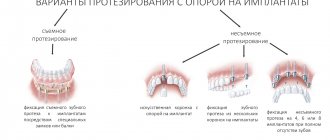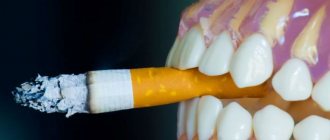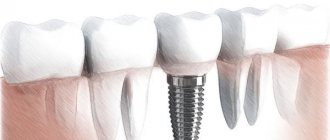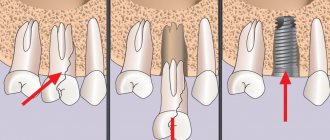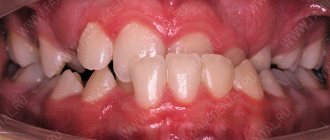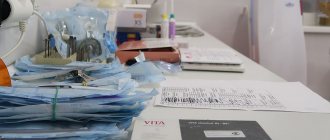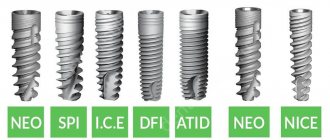All patients strive to spend as little time as possible in the dentist's chair, regardless of what manipulations the doctor performs. But, if we are talking about such an operation as the introduction of an artificial root into the jawbone, questions about the timing are asked especially often. Many people, even at the initial consultation stage, are interested in how long it takes to place a dental implant, believing that such a procedure lasts a long time.
Before answering this question, let us briefly dwell on the actions that a dental surgeon performs during such an intervention.
How long does it take to insert a tooth?
The duration of the tooth restoration procedure depends on the restoration method. If the tooth is destroyed by no more than 1/3 and has a intact root, it can be restored directly in the patient’s mouth in one visit. If the root is preserved and the crown part of the tooth is destroyed by more than 1/3, you can resort to microprosthetics, which is also performed in one visit.
If the coronal part is significantly destroyed and the tooth must be removed, implantation or installation of a bridge structure supported by adjacent teeth is indicated. If the patient chooses implantation, then modern protocols make it possible to restore the integrity of the jaw row in one or two visits. The traditional protocol involves allowing the implant to heal for about six months and, if osseointegration is successful, installing a permanent crown.
Fixation process
For the final installation of the orthopedic structure, the patient needs to spend 40-60 minutes in the dental chair. At that time:
- the prepared dental element is treated with an antiseptic;
- the oral cavity is dried out;
- a composition that increases adhesion is applied to the abutment tooth;
- The crown is placed on dental cement.
After this, you will have to spend another 30-40 minutes with an orthopedic dentist so that the specialist can assess the quality of pronunciation, degree of comfort and other categories indicating the correct installation of the prosthesis or the need for another adjustment, but on the installed structure.
Important! The correction can still be performed several times, i.e. until the desired result is achieved, which prolongs the period of prosthetics.
In the video, the specialist explains what needs to be done first for dental prosthetics.
How does the second stage of dental implantation proceed?
The second stage of dental implantation is marked by the installation of a gum former. The purpose of the implant system element is to create a beautiful contour of the gum line. With one-stage implantation, the former is installed immediately after implantation. The construction is removed at the second visit and replaced with a temporary crown on the abutment. With a traditional two-stage protocol, the former is installed only after 4-6 months, when the implant has successfully taken root. In this case, a second operation is performed, during which the gingival flap is excised, the plug is removed from the implant, the former is fixed, and the wound is sutured tightly.
Indications and contraindications for installing implants in one day
This type of prosthetics allows you to either restore an entire row of teeth or make a prosthesis for just one tooth. This method is recommended for:
- periodontal disease
- irritation of bone tissue
- receding gums
- complete absence of teeth
This technology allows you to insert teeth in one day and immediately return a beautiful smile and the ability to eat comfortably.
One-time implantation is especially good in cases of complete or almost complete absence of teeth, when there is no time for a long wait and you want to quickly return to a full life.
There are certain situations in which implantation in one day is not possible. A preliminary examination will help identify these indications, without which medical intervention should not begin. Contraindications to dental implantology are:
- advanced osteoporosis
- oncological diseases
- connective tissue pathologies
- poor blood clotting
- immune system disorders
- decompensated diabetes
- acute infectious diseases
- pregnancy and lactation
If the above indications are present, the doctor will recommend an alternative method of restoring the dentition.
How long can you wear implants without crowns?
If we consider a two-stage implantation protocol, then you will have to walk without permanent crowns for six months. To restore the aesthetics and chewing function of the dental system, temporary plastic crowns are fixed 2-3 months after surgery.
Permanent crowns are installed only after successful osseointegration of the implant into the bone tissue. Temporary crowns should be worn not only for aesthetics, but also to prevent atrophy of the bone tissue of the jaw arch and destabilization of the titanium rod.
Advantages of using innovative technologies
Dentistry has been actively developing and undergoing significant changes in recent years. Innovative technologies have become available to patients, making the process of dental restoration safer, faster, more reliable, more comfortable and of higher quality.
Such technologies include:
- CAD/CAM system. This is an abbreviated name for modern computer technology: where CAD - Computer-Aided Design - means design using computer programs, CAM - Computer-Aided Manufacture - production using computer technology.
The system makes it possible to automate all stages of the manufacturing process of an orthopedic structure. - Three-dimensional prosthetics (3D). It involves the inclusion of high-precision computer technologies in all stages of prosthetics, starting from diagnosing the condition of the dental system, ending with the development and creation of a prosthesis.
- CEREC system. This is a computer technology, the peculiarity of which is the production of a prosthetic structure directly in front of the patient’s eyes, i.e. in one visit to the clinic.
- Nobel Procera . Computer technology makes it possible to produce biocompatible, high-precision, ideal in functionality and aesthetics, durable prostheses.
The demand for new technologies in dental prosthetics is constantly growing. Their popularity is explained by a number of significant advantages:
- The patient's time is saved, i.e. The duration of the entire recovery process and the number of planned visits to the doctor are reduced.
- Cash costs are reduced due to the absence of payment for performing bone grafting in case of insufficient jaw bone volume and a reduction in clinic visits.
- The rehabilitation period is shortened and easier.
- There are no risks of complications associated with inaccurate fit, unnecessary trauma, damage to nerves and the maxillary sinus.
- The end result can be visualized, i.e. The patient can view the progress of prosthetics on the computer and see the result.
- Based on the complexity of the case, you can select the optimal prosthesis model or accurately determine the safe place for inserting the implant.
- Tissue trauma is minimal.
- Automation of the manufacturing process of prosthetic structures helps make them accurate and comfortable.
- The human factor is excluded.
What happens if the implant does not take root?
Implant failure is difficult to prevent. The causes of the pathology may be peri-implantitis, smoking, non-compliance with medical recommendations in the early and late postoperative period. If acute rejection occurs, removal of the titanium rod is indicated. Re-implantation is possible only after complete healing of the wound. Rejection can develop several years after the permanent crown is installed. A number of external and internal factors can provoke a pathological process and destabilization of the implant.
All diagnostic equipment is located in the clinic - you don’t need to go anywhere
In our Center, during the period of implantological treatment, correction of chronic diseases is carried out, consultations are carried out by a full-time anesthesiologist and an ENT doctor. All diagnostic equipment is located in the clinic, you do not need to go anywhere. Blood tests can also be taken without leaving the clinic; the results will be ready within a day.
Levin Dmitry Valerievich
Chief physician, Ph.D.
Selecting an implant system
The service life of an implant depends on the thoughtful choice of its type and shape in accordance with the bone tissue. Healing is influenced by design characteristics, including material, coating, thread, and connection to the abutment. Accurate placement of the implant at the correct angle is important. All this depends on the qualifications of the doctor.
Our Center uses exclusively Nobel Biocare root-shaped structures, which are guaranteed for life. The survival rate of Nobel implants is 99.3% . The company managed to achieve this through a special porous Ti-Unite coating, which replicates the chemical composition of a natural tooth root. The bone tissue does not perceive the implant as a foreign body and begins to fuse with it, ensuring reliable engraftment for life.
In the case of Nobel Biocare implants with Ti-Unite coating, which we use at the Center, successful engraftment can be judged within a few days after the operation.
Nobel Biocare implants with Ti-Unite coating
Implant installation methods
When installing implants, one- and two-stage methods are used, which affect the healing period. The doctor himself chooses which option is best suited in the clinical situation.
- Classical implantation (two-stage method) . First, only an artificial root is installed in the jaw, and the gum above it is sutured. After osseointegration of the implant with the bone, a crown is fixed to it. Osseointegration takes an average of two months, but depends on the characteristics of the patient.
- Implantation with immediate loading (one-stage method) . The crown is fixed onto the implant immediately after installing the titanium root. The implant takes root with light loads, which stimulates the formation of bone tissue around the implant, thus reducing the osseointegration time. But this protocol is indicated only if there is sufficient volume and quality of jaw bone tissue.
- Single-stage implantation . The implant is installed immediately after tooth extraction into the root socket. The blood clot turns into bone, which envelops the root already at the stage of its formation. This accelerates the process of osseointegration. But this method is possible if there are no inflammatory processes at the root of the tooth, and the bone corresponds to the parameters in terms of density and size.
Whatever method is chosen, it is important to maintain sterility during the procedure so as not to infect the implant bed.
Prosthetics is an important component of implantation
After the implant has healed, an abutment is put on it, and the crown is fixed on top with cement. It is possible for cement to penetrate under the gum, and if it is not cleaned out, the implant will fail. We have moved away from this outdated technology for fixing crowns, reducing the likelihood of implant failure. We fix metal-free zirconium dioxide crowns not with cement, but with a solid screw connection.
The hidden screw connection between the implant and the crown is the gold standard for completing implant treatment.
Compliance with recommendations and oral hygiene
The International Implant Foundation states that the cause of implant failure is poor hygiene and non-compliance with recommendations. Requirements that speed up survival and reduce the risk of complications:
- minimal trauma to the surgical area;
- brush your teeth with caution for the first three days;
- Do not eat too solid food for two weeks;
- do not stop taking prescribed medications;
- avoid hypothermia or overheating of the body;
- do not smoke or drink alcohol;
- do not hide alarming symptoms during the rehabilitation stage.


